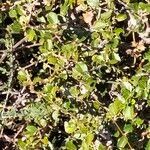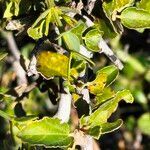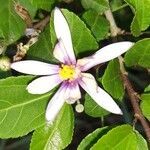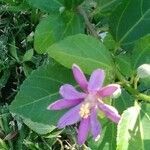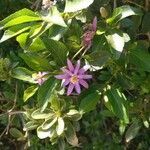Tree or shrub, up to 3 m high; branches slender, glabrescent. Leaves thin-textured, lanceolate to ovate-or rhomboid-lanceolate, base subcuneate to rounded, apex acute, margins crenate-dentate. Inflorescences leaf-opposed; peduncles up to 15 mm long, slender, glabrescent. Flowers ± 14 mm long, purple, mauve, pinkish or white. Sepals linear-oblong, up to 17.5 mm long, greenish outside, pink inside. Petals shorter than sepals. Androgynophore with basal glabrous portion ± 1 mm long, prolonged into densely pubescent portion up to 3 mm long. Flowering time Dec.-May. Fruit reddish purple, ± 25 mm in diam., 4-lobed, somewhat fleshy.
A scrambling shrub. It grows up to 6 m tall. The stems are flexible. They become four angled with age. The leaves are 2-8 cm long by 1.3-4 cm wide. The leaves are sword shaped. They have irregular blunt teeth along the edge. The flowers are pink to red. They are 2.5 cm across. Flowers occur as 1-3 together on slender stalks opposite the leaf. The fruit have 4 lobes. They are 2.5 cm across. The fruit is purple when ripe. Each lobe contains one seed. The fruit is edible.
Leaf-lamina 2–7·5 × 1·5–4 cm., lanceolate, rhombic-lanceolate or obovate-lanceolate, acute or rounded at the apex, margin crenate or crenate-dentate, subcuneate or rounded or slightly cordate at the base, glabrous or slightly pubescent on both surfaces, rather thin-textured; petiole up to 1·3 cm. long, glabrescent; stipules up to 4 mm. long, linear, pubescent, caducous.
Small tree or shrub, 3 m high. Leaves thin-textured, not discolorous, not glossy above, margin finely crenate-dentate. Fruit 4-lobed, brownish to purplish black. Flowers purple, mauve, pinkish or rarely white.
Petals purple, mauve, pinkish or very rarely white, up to 14 mm. long, oblong-lanceolate, with a basal nectariferous claw 1 mm. long circumvillous within and ledged above.
Shrub or small tree to 3 m. Leaves glabrescent, lanceolate, toothed. Flowers usually solitary opposite leaves, purple and pink or white. Fruits 4-lobed, reddish.
Inflorescences leaf-opposed, 1–3-flowered; peduncles slender, up to 15 mm. long, glabrescent; pedicels similar, up to 12 mm. long.
Androgynophore glabrous below for 1 mm. prolonged above into a densely pubescent portion up to 3 mm. long.
Shrub or small tree (rarely climbing) up to 3 m. tall with rather slender glabrescent branchlets.
Sepals up to 18 mm. long, linear-oblong, pubescent and greenish outside, purplish or pink inside.
Fruit reddish-purple, up to 2–5 cm. in diam., 4-lobed, shining, glabrescent, somewhat fleshy.
Ovary 4-lobed, densely hairy; style up to 10 mm. long, glabrous; stigma-lobes broad.
